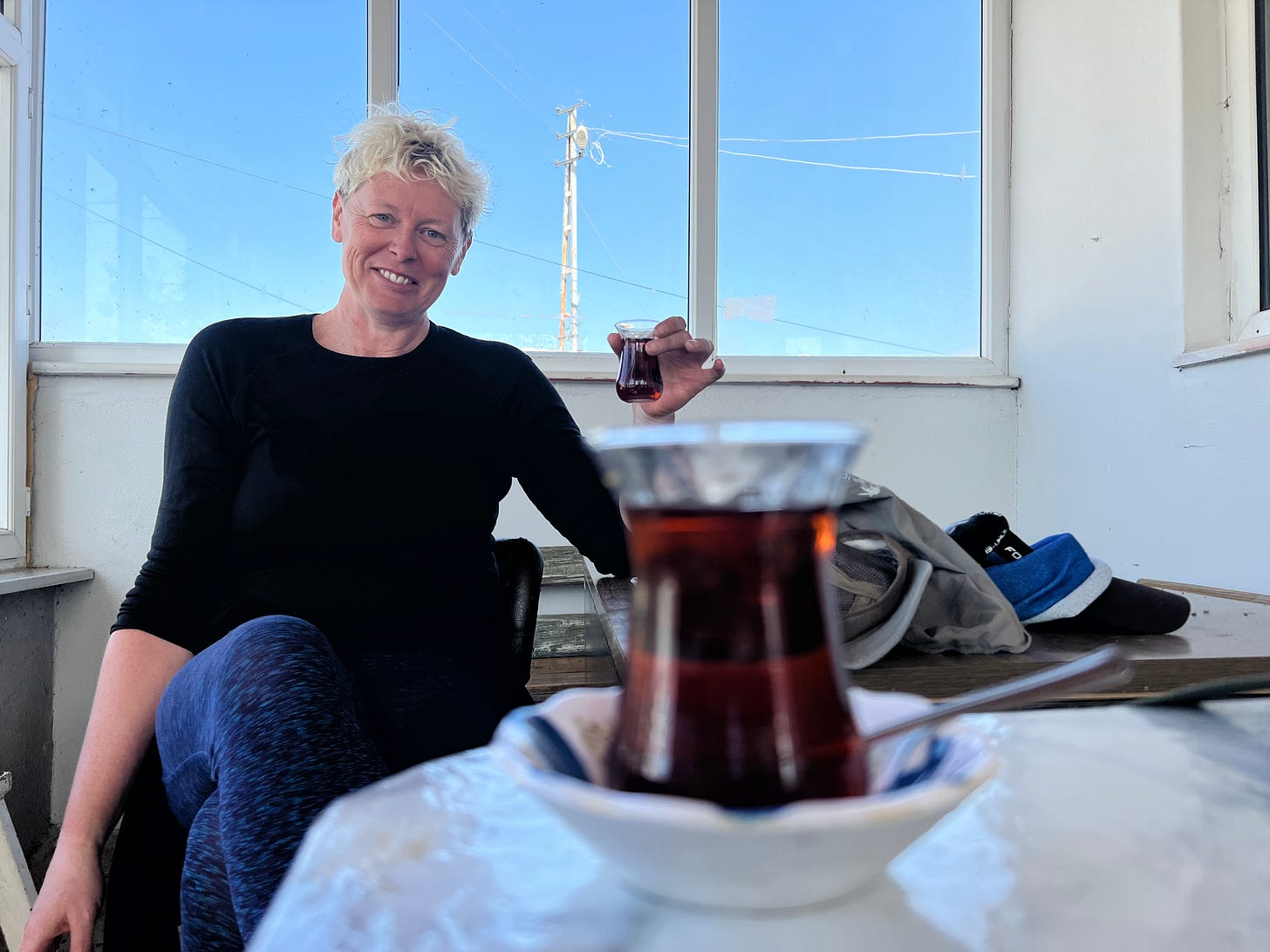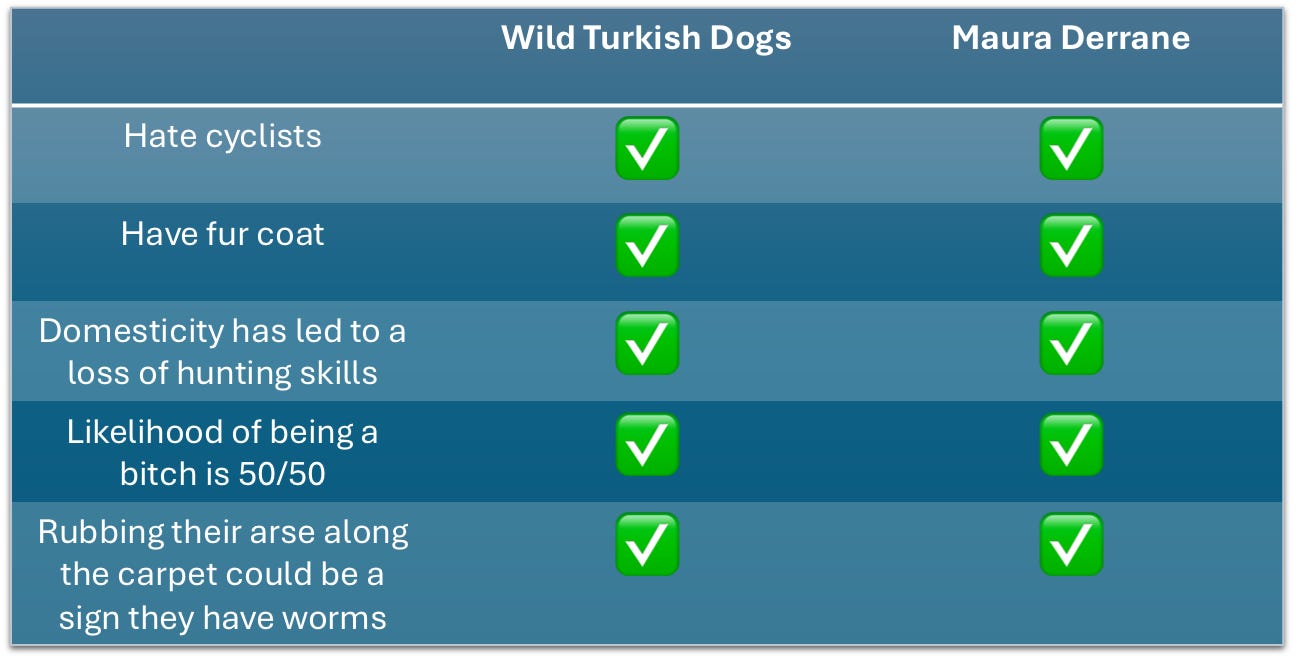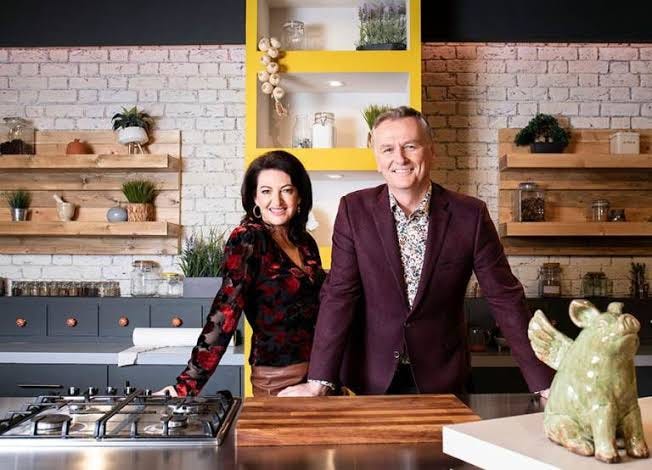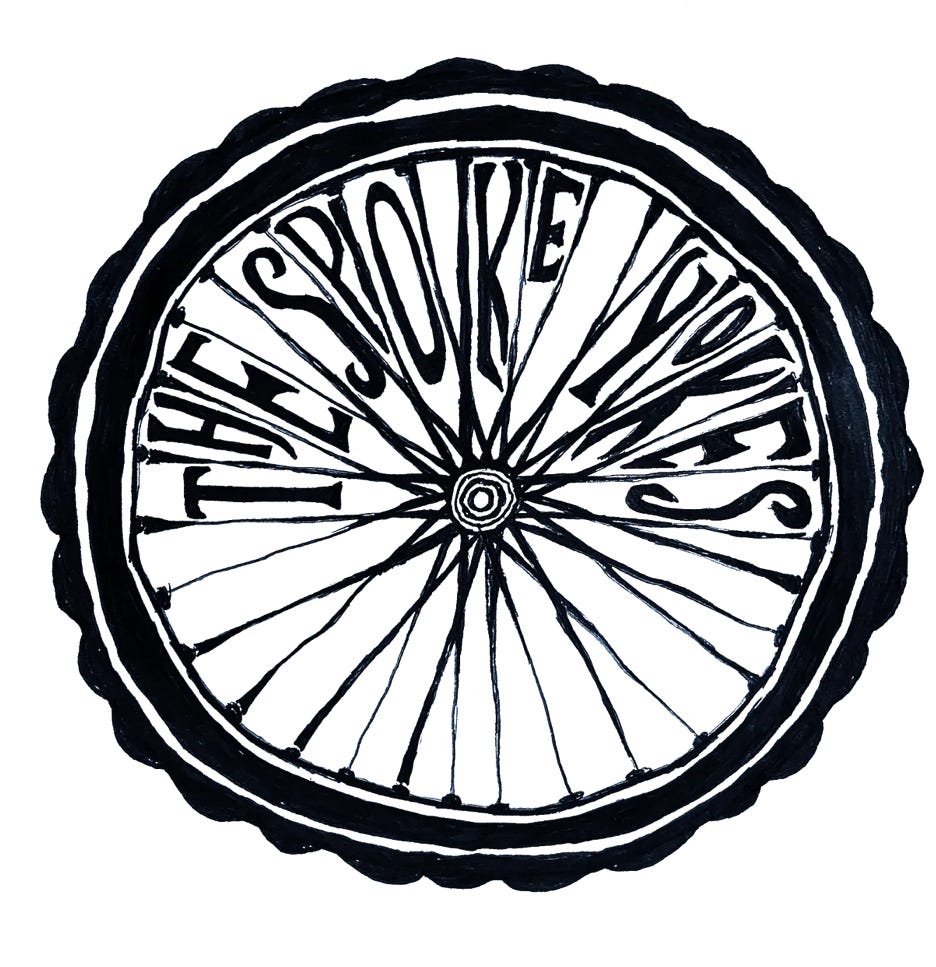Talkin’ Türkiye
Week 11 - A dose of Turkish delight as Mark and Ellie cross the Bosphorus, and a major milestone as they enter Asia Minor.
“You will have some tea,” insisted the deputy mayor of the village as we sat with himself and the mayor outside a teahouse in the Turkish village of Dereköy, about 10km from the border with Bulgaria.
“No thanks. We just had something.” “You will have another tea,” he persisted undeterred. We politely refused once more. ”Get them tea!” he declared. The tea duly arrived.
We’d only planned to have a short pit-stop to get our first taste of Turkey, having just crossed the border from Bulgaria, but as so often seems to be the case, we weren’t static for long when we attracted a crowd. Not often we get the head-honcho and his second-in-command heading up the welcoming committee though.
Our hankering for a nice cup of Barry’s Tea will not be a problem in Turkey. They know their tea here, and they make a damn fine double-boiled brew. The social structure of the country is steeped in tea.
Turkey is estimated to have the highest tea consumption per capita in the world. Ireland is second highest, and Britain is third. I’m counting that as a win for Ireland.
According to the International Tea Committee, the average Turkish person consumes four kilograms of tea leaf a year. That’s the equivalent of each of its 85 million inhabitants drinking four glasses a day, babies and tea-totallers included.
We asked the deputy mayor of Dereköy how many glasses of tea he drinks per day. “Any number between 10 and 50,” he responded, proud that he was tipping into the babies’ share. Sipping tea around a table, either inside or outside a teahouse, is how things get done in Turkey, albeit at a pretty relaxed pace.
We were only in the country for a couple of hours, but we were starting to get a sense of the place. “We’d better throw some shapes or we’ll be here for a week,” I whispered to Ellie, between slurps of tea and pleasantries with the village council.
As we continue through Turkish villages we regularly get called in to teahouses. I stopped off at a bike repair shop to replace a split cable housing, and they had a wood-burning stove in the middle of the workshop, with the large double-stacked kettle on the go.
Once the bike was sorted we were offered tea. We sat with Hakan and his family, sharing a glass, and having the chats as best we could. The tea-infused culture slows things down in the best way possible. Hakan’s sister acted as interpreter, and we got a little more insight into their lives and how this incredible country operates.
A country full of Mrs Doyles
When we do stop in villages we get offered more tea than we can handle, and no-one takes no for an answer. Sometimes when we try to pay for our tea, a row ensues. “You will not! Put that away,” but in Turkish.
We stopped in the village of Haçifakli for a cuppa. This spot is the epitome of a sleepy Turkish countryside village. There was a dog lying in the middle of the road as we entered town. He eyed us up lazily, and didn’t even bother barking, which was a nice change. There was a cut tree stump beside him with some bread crumbs on it, the haunt of a one-legged jackdaw.
There is no shop or mosque in Haçifakli, just a handful of houses and a teahouse. It’s a one-legged jackdaw kinda town. We ordered two teas, and before we’d taken our first sip we were joined by two elderly brothers, and the chat started. One of the brothers went to his scooter and took a packet of biscuits out of his shopping bag, opened them on the table, and told us to take five. With polite restraint we took one each. It seemed to us that these gentlemen were not wealthy, but you never know with those bachelor farmer types.
A third man joined us and a heated argument broke out that seemed to be about tractors. I reckon Eymen was a Massey man. It was very entertaining; a little uncomfortable, but entertaining. We were offered another cup of tea, and we accepted.
The argument that broke out when I tried to pay for the tea put the tractor turmoil in the ha’penny place. They were all in agreement that they were having none of it. They wouldn’t let us pay for anything at all. They were happy with the company and the diversion.
The kindness, welcome and hospitality that we’ve experienced in small Turkish villages so far is beating even Romania. “Is Turkey full of Mrs. Doyles?” Ellie asked as we pedalled out of a village with a tea surplus sloshing around inside us. She may be on to something.
We cycled further and further into the hills of Turkey, amazed at how much the sights, sounds, smells, and tastes could change so quickly. Minarets replaced spires, lamb kofte on roadside charcoal fires replaced pork mici, and unfortunately the countryside became full of packs of wild dogs.
Thankfully, for every barking and growling dog that pursues us along a country road, there are several humans who go out of their way to wish us well, on one occasion blocking oncoming traffic to do so. Apparently we were much more important than road safety.
The feeling of quickly going from one extreme to another, snarling dogs to smiling faces, is something Turkey is doing really well, keeping us unbalanced, on edge, but amazed and never bored.
It shouldn’t come as a surprise that things are pushed to extremes here. Istanbul alone has a population of 20 million people packed into a narrow stretch of land with the Black Sea to the north of it, the Mediterranean to the south, and the Bosphorus channel running through the middle. That point where Europe meets Asia is a bottleneck of people, water, culture and traffic.
There are many places we’ve agreed that we will need to revisit when we’ve finished this journey. However, another cycle into the metropolitan area of Istanbul is an extreme that I never want to repeat again in my life.
Sensory overload
Many other touring cyclists have left warnings online about the difficulties of navigating Istanbul by bike, and so with a mixture of regret and relief, we decided to abandon our half-formed plan to take in the sights of the city centre and opted instead to chart a course north of the city, and take one of the many ferry services from the somewhat quieter port town of Sariyer.
Even so, we tackled six lanes of traffic on one of the quieter arteries that surrounds the city. Trucks and cars blared past us. Being close to Istanbul airport, airplanes blasted over us. The call to prayer was banging out from tannoys atop minarets on either side of us. It was an auditory onslaught that was nerve wracking to cycle through, as the population of Istanbul made their way in and out of the city.
We had about 20 kilometres more to cycle that day to reach Sariyer, a northern suburb of the city. I didn’t know if I’d be able to sustain the concentration needed to bullishly maintain a straight line across the multiple exit and entrance ramps we needed to cross to stay on the hard shoulder of the motorway, while also dealing with the sensory onslaught going on around us.
Then just like that, with one turn off the road, the traffic was gone, we were cycling through wild woodland, beside a stream, down the side of a mountain towards the Bosphorus. From one extreme to another so quick it was dizzying and exhausting.
Crossing borders by bicycle is as exciting as it is addictive. The drawback is that it feels like we’re only getting to grips with the customs and culture of a place when we have to leave it, wipe the slate clean, and start all over again.
Since we began planning this trip five years ago, crossing into Turkey had come to represent a huge milestone for us. It signifies leaving what semblance of familiarity we might find in European countries and moving into Asia and the unfamiliar. It holds nervousness and excitement in equal measure.
We had braced ourselves for our most intense border crossing yet as we left Bulgaria. We expected that transition out of Europe and into the Middle East to be complicated, long, and at some point involve handing over cash for some nebulous tax that we’d read was not uncommon at the mountainous Malko Tarnovo crossing.
Three Turkish checkpoints, and a cursory search of one of my pannier bags, and within 45 minutes, without any requests for money from any Bulgarian or Turkish border officials, we were out the other side.
As we posed for our obligatory photo with the border sign welcoming us into a new country, heavily armed Turkish soldiers looked on from sand-bagged outposts beside the checkpoints, and more were stationed up on a hill overlooking the crossing. Thankfully they were nonplussed by our border selfie.
The crossing that we’ve dreamt about most isn’t actually a border crossing at all: it’s the natural crossing that lies within Turkey itself. It is the Bosphorus Strait, the corridor of water that runs from the Black Sea north of Istanbul, to the Marmaris and the Mediterranean Sea south of the city. The mighty Bosphorus is a body of water running through a wide, high-sided valley, presided over by the city of Istanbul.
Crossing the Bosphorus isn’t only a metaphorical transition or something we’ve imbued with a mythology or our own: taking the ferry 4km from Sariyer in the fishing village of Rumeli Kavaği would see us leave the continent of Europe and join the continent of Asia.
Controlling the Bosphorus has had massive economic, trade, and political implications for centuries. It is the sea route that links Russia, Ukraine, Romania, Bulgaria, Georgia and Turkey to the rest of the world.
The channel also acts as a cultural border, delineating east from west, even among Turkish people themselves. We’ve been told to expect things to be more traditional and old skool once we cross over to the Anatolian side.
We cycled here
It’s astounding to us that our piddling little legs have pushed our pedals all the way from The Prom in Tramore Co. Waterford, across the entire continent of Europe, to Istanbul, across the Bosphorus and into Asia Minor. This is where we find ourselves: on our bicycles, in Asia. As Ellie likes to say when these moments of wonder and disbelief catch up with us, “we cycled here.”
Minarets, the call to prayer that maps out the day, and copious amounts of tea are some of the most noticeable changes as we make our way along the Turkish road, but we’ve noticed the wildlife changing too. Crested larks punctuated our summer spin through greener and more luscious than expected Turkish farmland. Water buffalo lazily strolled across meadows. Lizards have been darting across the road, and we spotted a large terrapin scuttle into a stream as we rolled past.
Jackals sound disconcertingly like babies when they screech in the night, which can be unsettling, but it’s exciting to see them break cover and tear across country roads as we cycle along. We’ve also stopped on a couple of occasions beside swampy basins to appreciate the frog chorus.
“How much would you need to wear that scarab beetle as a live earring for a week?” I asked Ellie as a particularly large specimen with huge pincers crossed the road in front of us. “With its legs kicking against your neck”, I added. Ellie thought about it and responded, “Seven thousand euros. You can put up with anything once you get used to it.”
We’ve discussed going into the business of couples therapy when we’ve finished this cycle. We reckon we’re getting good training. “You can put up with anything once you get used to it,” would be an ideal title for our couples self-help book. We might leave out the chapter about our argument about whether or not the Bosphorus is a river. Let’s be clear about this: it most certainly is not.
“f@€k off, dog!”
We’ve developed some interesting team tactics for dealing with the wild dogs. I’ve taken to barking “f@€k off” at them as loudly and gruffly as I can manage while cycling. It works sometimes.
Ellie devised a squirty bottle system that sees us squirting chili-infused water at them when my barking doesn’t do the trick and when they are particularly aggressive and dangerous. It may sound cruel, but it’s a last resort for the really big and vicious ones. So far we remain chased, but unbitten.
We’ve started calling the more vicious dogs Maura, in honour of Irish daytime TV presenter Maura Derrane. A few years ago Maura appeared on an Irish television show, and compared cyclists to farm animals, because they annoy her on the road. She illustrated her annoyance by throwing a bicycle helmet into a rubbish bin while on-air.
We started the comparison of Maura and wild Turkish dogs because of their mutual ravening hatred of cyclists, but we’ve started exploring whether the doyenne of daytime TV and stray pooches might have more in common than just their hatred of bicyclists. Below is a table of things we suggest Maura Derrane and wild Turkish dogs may (or for legal reasons may not) have in common. We’d be delighted to hear some of your own suggestions in the comments.
In another shift of Turkish extremes, one dog ran after us as we made our way towards the Bosphorus ferry. But this dog did not bark or try to bite our ankles.
Instead he ran beside us, as if protecting us.
When we stopped, he would lie beside our bikes, protecting them. If mopeds or motorcycles passed us on the other side of the road, he would bark ferociously and run at them full tilt, seemingly under the impression that there is a sort of running feud between bicycles and mopeds. He knew what side he was on.
He seemed really happy to accompany us for several kilometres through towns, and at speed down steep hills. It was a bit of a relief when we parted ways at the ferry port, because we were worried he’d get hit by a car or motorcycle when he chased oncoming traffic to protect us.
He was really nice, but not very bright. We called him Dáithí.
Hold her steady and keep it between the ditches!









Bravo both! Europe, tick. Enjoy and don’t forget to have a cuppa for me. X
Turkey...so far ,so good.Yay! Poor Maura 😢..but I guess she gets what she deserves. Hilarious ! Keep us posted ❤️